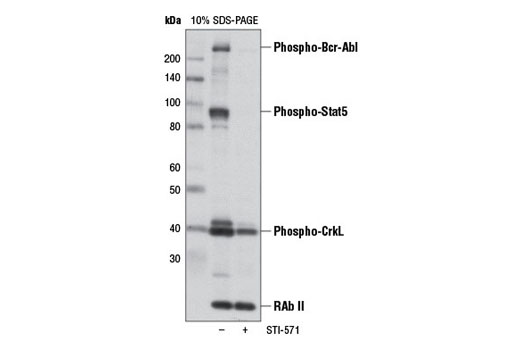WB
H
Endogenous
Rabbit
#P62491, #Q15907, #P46109, #P42229, #P51692, #P00519
8766, 9230, 1399, 6776, 6777, 25
Product Information
Storage
Specificity / Sensitivity
Species Reactivity:
Human
Source / Purification
Antibodies are produced by immunizing animals with synthetic peptides. Polyclonal antibodies are purfied by protein A and peptide affinity chromatography.
Product Description
Background
STI-571 (also known as Imatinib mesylate) is a tyrosine kinase (TK) inhibitor that is a relatively specific ATP-binding site antagonist of Bcr-Abl, PDGF receptor and c-Kit TKs (1-3). Results are encouraging in CML clinical trials, and STI-571 has become a paradigm for targeted cancer therapeutics (4-6). Signal transduction through phospho-tyrosine pathways has been studied extensively, and tyrosine phosphorylation has been linked to multiple cell growth and differentiation pathways (7-9). Because the observed leukemic state of CML is dependent on the intact Bcr-Abl tyrosine kinase activity, extensive work has been done to identify substrates of Bcr-Abl and thus possible mechanisms leading to a myeloid expansion. Many groups have characterized prominent tyrosine-phosphorylated protein substrates in both CML blasts and Bcr-Abl-expressing cell lines, including SHIP, c-cbl, Dok, SHC and CrkL (10-15). In addition, key signal transduction pathways involving PI3 kinase, Ras, Myc and Stat5 are also activated in a Bcr-Abl kinase-dependent manner (16).
- Buchdunger, E. et al. (1996) Cancer Res 56, 100-4.
- Heinrich, M.C. et al. (2000) Blood 96, 925-32.
- Druker, B.J. et al. (1996) Nat Med 2, 561-6.
- Mauro, M.J. and Druker, B.J. (2001) Curr Oncol Rep 3, 223-7.
- Druker, B.J. et al. (2001) N Engl J Med 344, 1031-7.
- Druker, B.J. et al. (2001) N Engl J Med 344, 1038-42.
- Blume-Jensen, P. and Hunter, T. (2001) Nature 411, 355-65.
- Ullrich, A. and Schlessinger, J. (1990) Cell 61, 203-12.
- Cantley, L.C. et al. (1991) Cell 64, 281-302.
- ten Hoeve, J. et al. (1994) Blood 84, 1731-6.
- Matsuguchi, T. et al. (1994) J Biol Chem 269, 5016-21.
- Carpino, N. et al. (1997) Cell 88, 197-204.
- Sattler, M. et al. (1997) Oncogene 15, 2379-84.
- Di Cristofano, A. et al. (1998) J Biol Chem 273, 4827-30.
- Wisniewski, D. et al. (1999) Blood 93, 2707-20.
- Kabarowski, J.H. and Witte, O.N. (2000) Stem Cells 18, 399-408.
Species Reactivity
Species reactivity is determined by testing in at least one approved application (e.g., western blot).
Western Blot Buffer
IMPORTANT: For western blots, incubate membrane with diluted primary antibody in 5% w/v BSA, 1X TBS, 0.1% Tween® 20 at 4°C with gentle shaking, overnight.
Applications Key
WB: Western Blotting
Cross-Reactivity Key
H: human M: mouse R: rat Hm: hamster Mk: monkey Vir: virus Mi: mink C: chicken Dm: D. melanogaster X: Xenopus Z: zebrafish B: bovine Dg: dog Pg: pig Sc: S. cerevisiae Ce: C. elegans Hr: horse GP: Guinea Pig Rab: rabbit All: all species expected
Trademarks and Patents
Limited Uses
Except as otherwise expressly agreed in a writing signed by a legally authorized representative of CST, the following terms apply to Products provided by CST, its affiliates or its distributors. Any Customer's terms and conditions that are in addition to, or different from, those contained herein, unless separately accepted in writing by a legally authorized representative of CST, are rejected and are of no force or effect.
Products are labeled with For Research Use Only or a similar labeling statement and have not been approved, cleared, or licensed by the FDA or other regulatory foreign or domestic entity, for any purpose. Customer shall not use any Product for any diagnostic or therapeutic purpose, or otherwise in any manner that conflicts with its labeling statement. Products sold or licensed by CST are provided for Customer as the end-user and solely for research and development uses. Any use of Product for diagnostic, prophylactic or therapeutic purposes, or any purchase of Product for resale (alone or as a component) or other commercial purpose, requires a separate license from CST. Customer shall (a) not sell, license, loan, donate or otherwise transfer or make available any Product to any third party, whether alone or in combination with other materials, or use the Products to manufacture any commercial products, (b) not copy, modify, reverse engineer, decompile, disassemble or otherwise attempt to discover the underlying structure or technology of the Products, or use the Products for the purpose of developing any products or services that would compete with CST products or services, (c) not alter or remove from the Products any trademarks, trade names, logos, patent or copyright notices or markings, (d) use the Products solely in accordance with CST Product Terms of Sale and any applicable documentation, and (e) comply with any license, terms of service or similar agreement with respect to any third party products or services used by Customer in connection with the Products.
